Any improvement in photographic optics is fine, and we’ve seen quite a few technological breakthroughs in recent decades. But one of the most impressive advances is the invention of optical image stabilization, which offers photographers never-before-seen possibilities. Just one example: evil tongues claim that the great Cartier-Bresson abandoned photography and switched to painting not least because of hand tremor, which arose at an advanced age it was not so problematic for painting . If his camera had an effective stabilization system – and who knows, how many more masterpieces the world would be enriched.
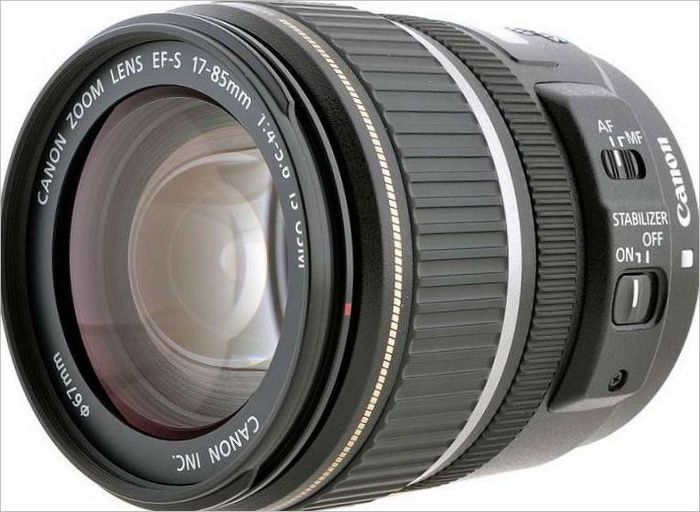
The essence of the stabilization system is simple: since a person is not able to hold the camera perfectly still he breathes, the blood in his hand pulsates, etc. . d. , then some moving element and sensor system are placed in the “camera-lens” system. Sensors detect motion and direction and send a signal to the moving element, which moves to the opposite side to the movement of the camera, thus compensating the vibration and providing a sharp image without blurring.
The speed at which the sensors and the moving elements work determines the efficiency of the stabilization system, which is measured in stops won. For example, if you shoot with a 50 mm lens, if the stabilizer provides sharp images at a shutter speed of 1/30 s instead of the standard 1/60 s , its efficiency is 1 step, if you can shoot at 1/15 s, two steps, at 1/8 s, three steps, and so on. The best modern stabilization systems give the photographer more than four steps of freedom in shutter speed selection.
Canon’s EF 75-300 f/4-5.6 IS USM telezoom, released in the autumn of 1995, was the first use of optical stabilization in photography. A few years later Minolta introduced its own version of optical stabilization, but it followed a radically different path: while Canon compensated the vibration of the camera-lens system by shifting the lens group in the lens, Minolta chose to shift the sensor itself.
The demand for optical stabilization has led to the fact that it is now used in a large proportion of lenses, including outright budget lenses. When choosing a lens it is important to remember that it improves with time, so more recent developments tend to have a more effective stabilization system.
Thus, if the first lenses with stab made claims for winning two steps of exposure time and in practice even this sometimes appears to be an exaggeration , the latest models can unashamedly proclaim four steps which has been frankly proved by practice.
The number of motion sensors and axes on which the compensating unit moves is increasing, and recently there are also stabilization systems in which the moving lens group in the lens not only moves up and down and right and left, but also forward and backward in relation to the sensor, which is critical for macrophotography. In general, the engineers of photographic companies do not sit idly by, and perhaps we can not imagine what we will enjoy the progress in the future.
In this review we have limited ourselves to budget lenses mainly because we can say with confidence that they have a very good stabilization system and it hardly needs our recommendations.
READ MORE:
All-new-format lenses: an overview of lenses for mirrorless cameras.
Wide Field of View: Overview of Wide Angle Lens Models
The new elite: APS-C zoom lens reviews
Back to the basics: fixed focal length lens reviews.
Light is power : A survey of professional light zooms for full-frame cameras.
Canon EF-S 15-85mm f/3.5-5.6 IS USM
|
Bayonet |
Canon EF-S |
|
Image Format |
22.3 × 14.9 mm |
|
Lens design |
17 elements in 12 groups |
|
Focal length |
15-85 mm |
|
Focal length 35mm equivalent. |
24-136 mm |
|
maximum aperture |
3,5-5,6 |
|
Minimum aperture |
22-38 |
|
Angle of view |
84° – 184° |
|
Minimum focus distance |
35 cm |
|
Maximum magnification |
0,21h |
|
Number aperture diaphragm blades |
7 rounded |
|
Hood type |
EW-78 E |
|
Light filter diameter |
72 mm |
|
Additional features |
Optical stabilizer 4x |
|
Dimensions |
81.6 × 87.5 mm |
|
Weight |
575 g |
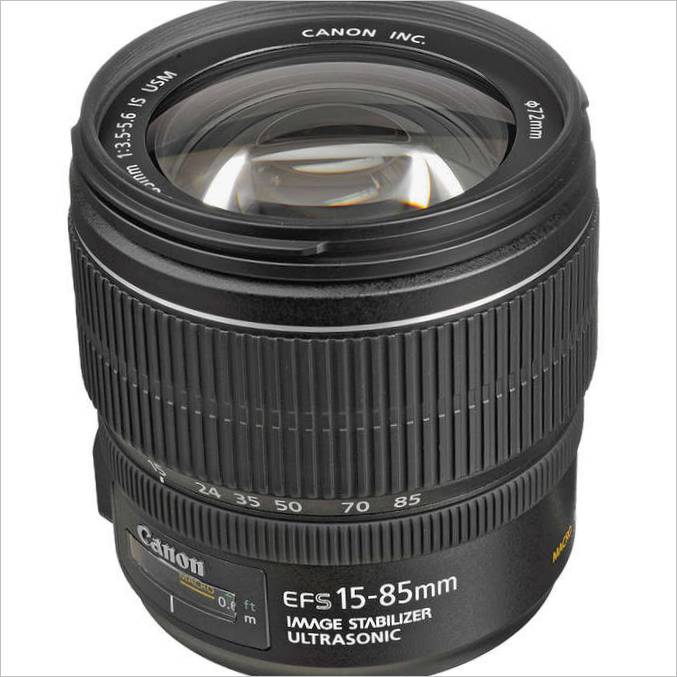
A relatively new released in October 2009 standard APS-format DSLR zoom, offering a larger eq. 24-136 mm . Stabilization system claimed efficiency of up to 4 steps. Super-low dispersion element and three aspherical lens elements in the optical design, ensuring high correction of most distortions. Images are sharp throughout the frame, even with the diaphragm fully open, especially in the wide- and medium-diameter focal range. In the telephoto range at an open aperture the sharpness in the corners drops a little, but on the whole the image remains more than acceptable even without aperture.
Price $630 [IN BEGINNING OF REVIEW]
Canon EF-S 17-55mm f/2.8 IS USM
|
Mount |
Canon EF-S |
|
Image Format |
22.3 × 14.9 mm |
|
Lens construction |
19 elements in 12 groups |
|
Focal length |
17-55mm |
|
Focal length 35mm equivalent. |
27-88mm |
|
Maximum aperture |
2,8 |
|
Minimum aperture |
22 |
|
Angle of View |
78° – 27,5° |
|
Minimum focus distance |
36.6 cm |
|
Maximum magnification |
0,17h |
|
Number of aperture blades |
7 rounded |
|
Hood type |
EW-83J |
|
Light Filter Diameter |
77 mm |
|
Extra features |
optical stabilizer |
|
Dimensions |
83.8 × 111.8 mm |
|
Weight |
635 g |
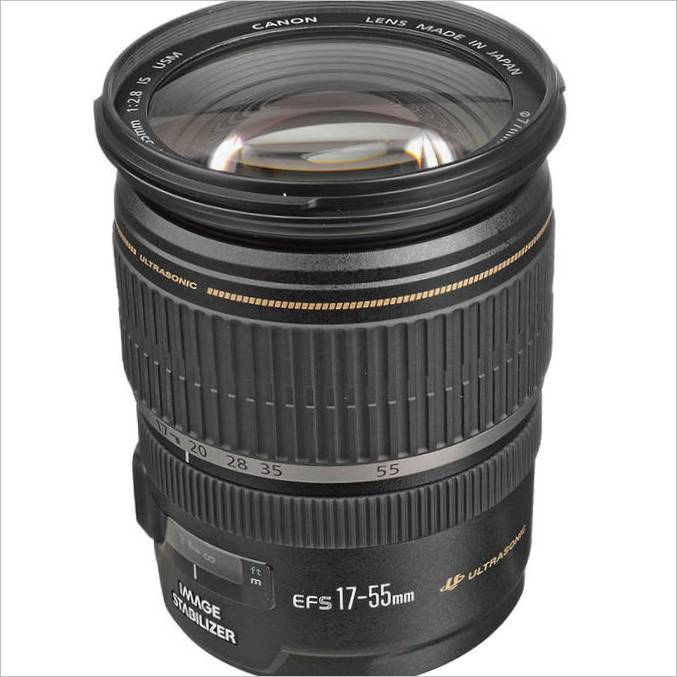
Canon has not yet developed a single L-class lens for APS format cameras, but the standard 17-55mm zoom lens with F2.8 aperture ratio is one of the top candidates for entry into the professional class. Released in spring 2006, it boasts a three-stop stabilization system. Digitally optimized optics featuring an ultra-low dispersion element and three aspherical lens elements for superior image quality, while the proprietary Super Spectra coating combats glare and flare. Ring AF drive means instant, silent autofocus, with the option to manually adjust focus at any time.
Price $930 [IN BEGINNING OF REVIEW]
Canon EF-S 17-85mm f/4-5.6 IS USM
|
Bayonet |
Canon EF-S |
|
Image format |
22.3 × 14.9 mm |
|
Lens construction |
17 elements in 12 groups |
|
Focal length |
17-85mm |
|
Focal length 35mm eq. |
27-136 mm |
|
Maximum aperture |
4-5,6 |
|
Minimum aperture |
22-32 |
|
Angle of view |
78° – 18° |
|
Minimum focus distance |
35 cm |
|
Maximum magnification |
0,2h |
|
Number aperture diaphragm blades |
6 rounded |
|
Hood type |
EW-73B |
|
Light filter diameter |
67 mm |
|
Optional features |
Optical stabilizer 3x |
|
Dimensions |
78.5 ×92 mm |
|
Weight |
475 g |
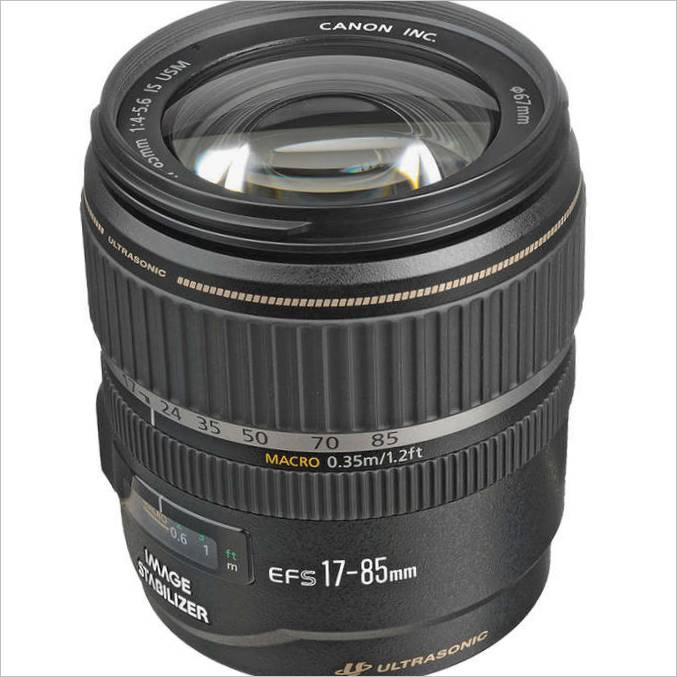
Lightweight and versatile, the 5x standard zoom covers a range of focal lengths equivalent to 28-135mm and offers excellent value for money. Released back in 2004, so the stabilization system gives you two or three extra shutter speeds, which is not much these days. Uses several special optical elements, including a double-sided aspherical lens, which provides high sharpness and contrast throughout the frame the rounded aperture beautifully blurs the defocus area. Great for travel: compact and relatively inexpensive, it produces decent level images, while the long zoom range means you don’t have to replace your lenses too often.
Price $360 [IN BEGINNING OF REVIEW]
Canon EF-S 18-55mm f/3.5-5.6 IS STM
|
Bayonet |
Canon EF-S |
|
Image Format |
22.3 × 14.9 mm |
|
Lens construction |
13 elements in 11 groups |
|
Focal length |
18-55mm |
|
Focal length 35mm eq. |
29-88mm |
|
Maximum aperture |
3,5-5,6 |
|
Minimum aperture |
22-38 |
|
Angle of view |
74° – 28° |
|
Minimum focusing distance |
25 cm |
|
Maximum magnification |
0,36h |
|
Number of aperture blades |
7 rounded |
|
Hood type |
EW-63C |
|
Light Filter Diameter |
58 mm |
|
Additional features |
Optical stabilizer 4x , STM autofocus drive |
|
Dimensions |
69.1 × 75.2 mm |
|
Weight |
205 g |
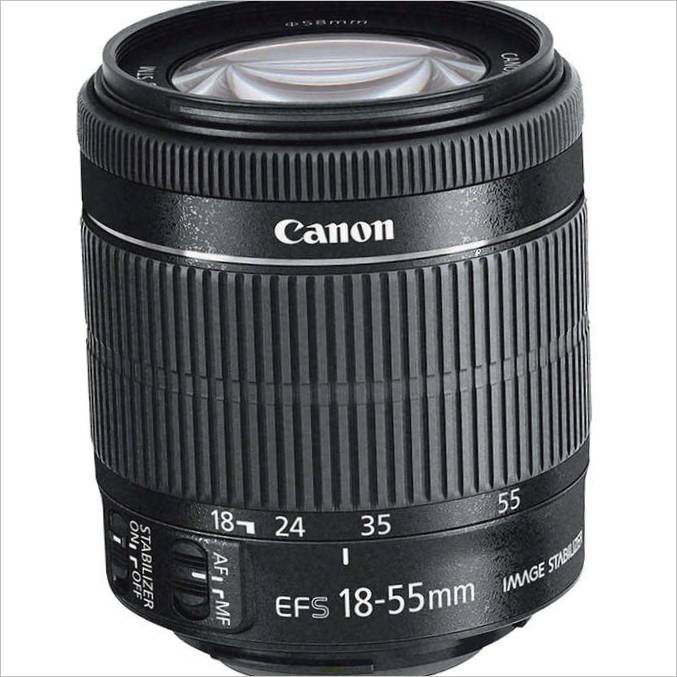
The newest and most advanced version to date of the budget “kit” zoom for APS-format cameras. The title “whale” suggests that for a huge part of amateurs it is destined to be the main and often the only lens in the first years of photography, and it is responsible for the first impression of the brand. So for all their love of economy, manufacturers pay special attention to the kit lens and equip it to the max. In this case, the “chip” is hidden behind the abbreviation STM, which means a stepping motor: it provides a fast yet smooth and quiet continuous auto focus, required for quality video, and smooth aperture changes in older versions, it changed in jumps, which are very bad looking in movies . Stabilizer efficiency is 4 steps and the aspherical lens provides a very decent image.
Price $130 [IN THE BEGINNING OF THE REVIEW]
Canon EF-S 18-135mm f/3.5-5.6 IS STM
|
Mount |
Canon EF-S |
|
Image Format |
22.3×14.9mm |
|
Lens construction |
16 elements in 12 groups |
|
Focal length |
18-135 mm |
|
Focal length 35mm equivalent. |
29-216 mm |
|
Maximum aperture |
3,5-5,6 |
|
Minimum aperture |
22-36 |
|
Angle of view |
74° – 11° |
|
Minimum focus distance |
45 cm |
|
Maximum magnification |
0,21h |
|
Number of aperture blades |
6 rounded |
|
Hood type |
EW-73B |
|
Light filter diameter |
67 mm |
|
More features |
Optical Image Stabilizer 4x , STM autofocus drive |
|
Dimensions |
75.4 ×101mm |
|
Weight |
455 g |
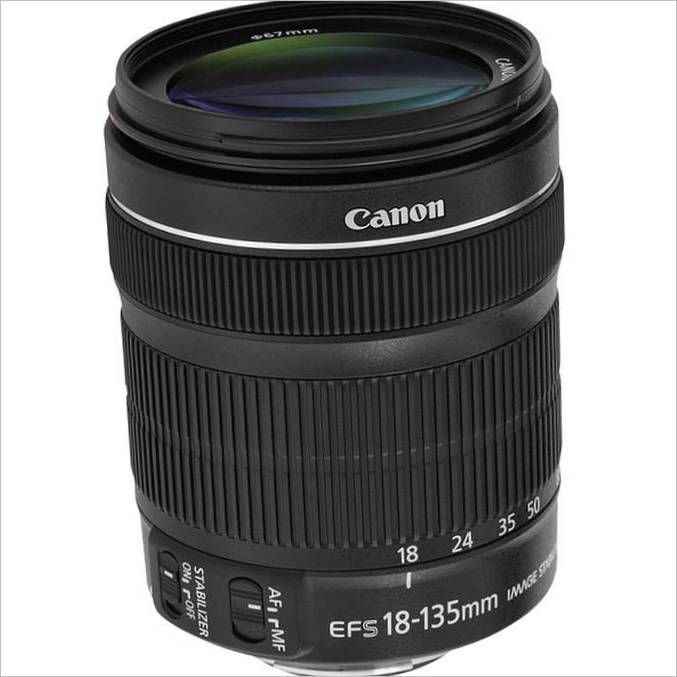
Budget 7.5x superzoom focal length range eq. 29-216 mm for the photographer who is not ready to put up with the austerity of an elementary kit lens. Launched in June 2012, this lens boasts the very latest functions, including an STM stepper AF motor that keeps the image sharp while shooting movies reliably and quietly and a highly effective four-stop sharpening system. Canon’s first use of “dynamic stabilization” ensures steady images even when shooting movies on the go. Please note, however, that you can realize the full potential of the stepper motor only with the latest SLRs. Compact and lightweight, special optical elements effectively suppress aberrations. Has a different optical design than its predecessor, the EF-S 18-135mm f/3.5-5.6 IS.
Price $390 [IN BEGINNING OF REVIEW]
Canon EF-S 18-200mm f/3.5-5.6 IS
|
Bayonet |
Canon EF-S |
|
Image format |
22.3×14.9mm |
|
Lens construction |
16 elements in 12 groups |
|
Focal length |
18-200 mm |
|
Focal length 35 mm Eq. |
29-320 mm |
|
Maximum aperture |
3,5-5,6 |
|
Minimum aperture |
22-36 |
|
View angle |
74° – 7° |
|
Minimum focus distance |
45 cm |
|
Maximum magnification |
0,24h |
|
Number of aperture diaphragm blades |
6 rounded |
|
Hood type |
EW-78D |
|
Light filter diameter |
72 mm |
|
Optional features |
optical stabilizer 4x |
|
Dimensions |
78.7 × 101.6 mm |
|
Weight |
595 g |
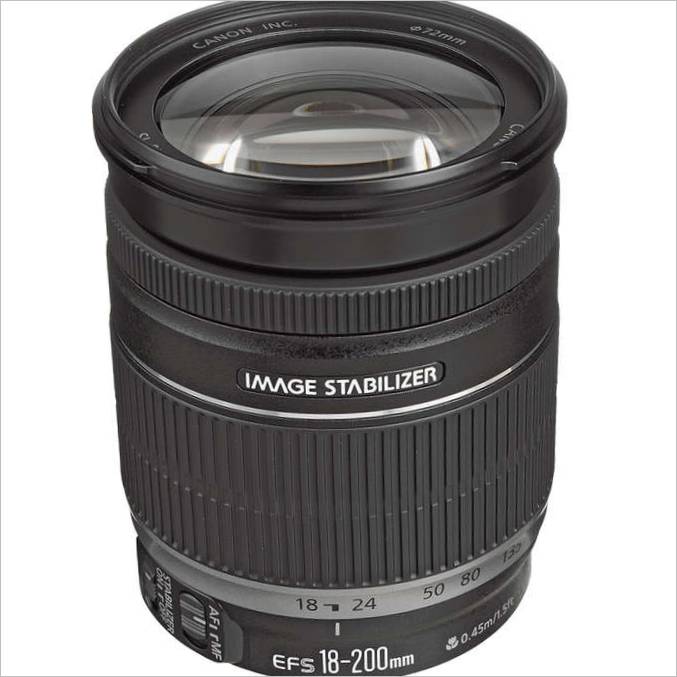
Despite the impressive 11x zoom range, the 18-200mm f/3.5-5.6 IS quite compact and lightweight for its class. Released in the fall of 2008, it has a stabilizer with about 4 shutter speeds. The stabilization system automatically detects intentional wiggling taking pictures of moving objects with the lens following the subject the background is rendered blurred as if in motion, and the subject is relatively sharp and turns off compensation along the appropriate axis – t. e. If the lens is wired horizontally, only vertical lens movements are compensated for. Two ultra-low dispersion elements and multiple aspherical lenses deliver outstanding image quality with high sharpness and contrast. The exterior design closely resembles that of the L-series lenses.
Price $450 [IN BEGINNING OF REVIEW]
Canon EF-S 55-250mm f/4-5.6 IS STM
|
Bayonet |
Canon EF-S |
|
Image format |
22.3×14.9 mm |
|
Lens construction |
15 elements in 12 groups |
|
Focal length |
55-250mm |
|
Focal length 35mm eq. |
88-400 mm |
|
Maximum aperture |
4-5,6 |
|
Minimum aperture |
22-32 |
|
Angle of view |
28° – 6° |
|
Minimum focus distance |
85 cm |
|
Maximum magnification |
0,29h |
|
Number of aperture blades |
7 rounded |
|
Type of lens hood |
ET-63 |
|
Light filter diameter |
58 mm |
|
More options |
Optical Image Stabilizer 3.5x , STM autofocus drive |
|
Dimensions |
70 × 111.2 mm |
|
Weight |
375 g |
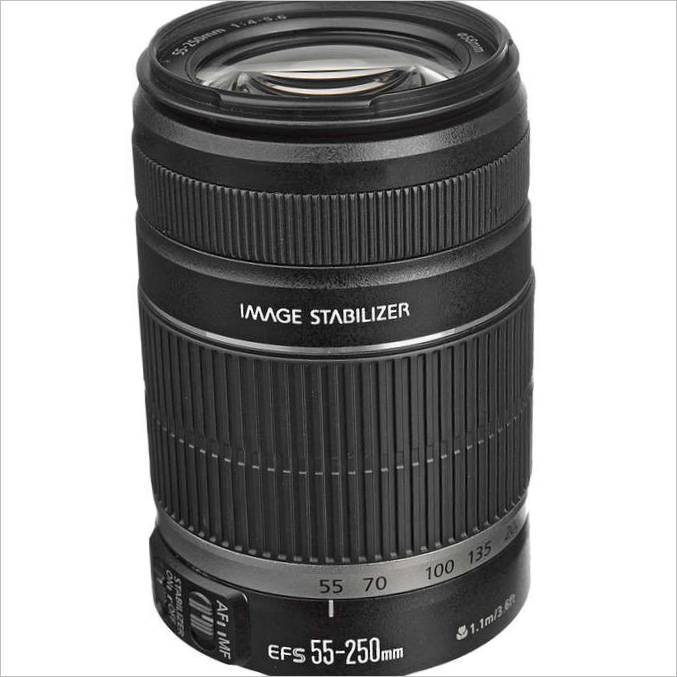
One of only three today zooms using the latest stepping motor for autofocus STM . This technology allows you to shoot video with the smoothness, speed and precision of autofocus previously available only to super-professional systems although it only works with the latest cameras . Developed as a companion to the 18-55mm STM kit zoom, the low-zoom is known to provide better image quality than superzooms, so two lenses instead of one makes a lot of sense. Stabilization system gives photographers 3.5 additional shutter speeds and automatically detects wired shots. Ultra-low dispersion element delivers sharp, contrast-rich images.
Price $380 [IN BEGINNING OF REVIEW]
Canon EF 35mm f/2.0 IS USM
|
Bayonet |
Canon EF |
|
Image Format |
24×36 mm |
|
Lens construction |
10 elements in 8 groups |
|
Focal length |
35 mm |
|
Focal length |
(for APS format, Eq. 56 mm |
|
Maximum aperture |
2 |
|
Minimum aperture |
22 |
|
Angle of view |
63° |
|
Minimum focus distance |
24 cm |
|
Maximum zoom |
0,24h |
|
Number of aperture blades |
8 rounded |
|
Hood type |
EW-72 |
|
Light filter diameter |
67 mm |
|
Optional features |
Optical Image Stabilizer 4x |
|
Dimensions |
78.7 × 63.5 mm |
|
Weight |
335 g |
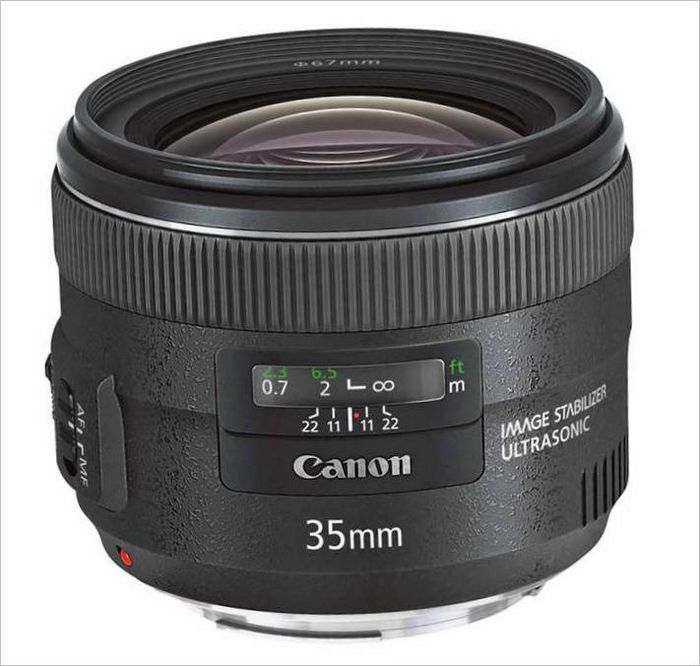
Canon’s latest class of completely new image quality lenses, the wide-angle ‘discreet’ lens with IS 28mm and 24mm focal lengths available . F2.0 is not the brightest when using a 35mm lens, but this new lens boasts fantastic image quality across the entire image area, even at fully open aperture, so if you don’t need to use f/1.4 very often, we can recommend it to the most demanding photographer. An eight-blade aperture diaphragm ensures beautiful bokeh and a ring AF motor for instant, silent focusing. Stabilizer efficiency – 4 diaphragm steps, the system automatically detects the wire and switches to the optimal stabilization mode.
Price $800 [IN THE BEGINNING OF THE REVIEW]
Canon EF 28-135mm f/3.5-5.6 IS USM
|
Bayonet |
Canon EF |
|
Image format |
24×36 mm |
|
Lens design |
16 elements in 12 groups |
|
Focal length |
28-135mm |
|
Focal length |
(for APS format, Eq. 45-216 mm |
|
Maximum aperture |
3,5-5,6 |
|
Minimum aperture |
22-36 |
|
Angle of view |
75° – 18° |
|
Minimum focus distance |
50 cm |
|
Maximum magnification |
0,19h |
|
Number of aperture blades |
6 rounded |
|
Hood Type |
EW-78B II |
|
Light filter diameter |
72mm |
|
Additional capabilities |
optical stabilizer 1.5-2x |
|
Dimensions |
78.4 × 96.8 mm |
|
Weight |
540 g |
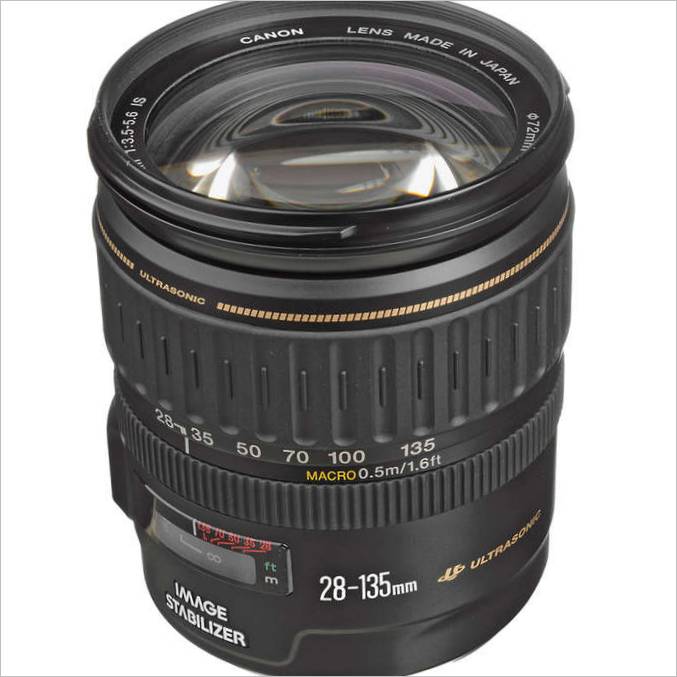
Like Peter the Great’s boat, this lens is the granddaddy of a large fleet of stabilized optics: released back in February 1998, it was the second stabilized lens from Canon’s pioneering company. Respectively, the efficiency of the system is insignificant – only one and a half steps in the wide angle range and two steps in the telephoto range. Nevertheless its versatility, relative low cost, ability to be mounted on full frame cameras and – most importantly – the fact that it is long and well proven have led to the fact that the patriarch is still in demand and widely represented on the market. Among the useful features is the ability to manually adjust the focus in any focus mode.
Price $380 [IN THE BEGINNING OF THE REVIEW]
Canon EF 70-300mm f/4-5.6 IS USM
|
Bayonet |
Canon EF |
|
Image format |
24×36 mm |
|
Lens Design |
15 elements in 10 groups |
|
Focal length |
70-300 mm |
|
Focal length |
(for APS format, Eq. 112 mm to 480 mm |
|
Maximum aperture |
4-5,6 |
|
Minimum aperture |
32-45 |
|
Angle of view |
34° – 8° |
|
Minimum focus distance |
150 cm |
|
Maximum magnification |
0,26h |
|
Number of aperture blades |
8 rounded |
|
Type of hood |
ET-65B |
|
Light filter diameter |
58mm |
|
Optional features |
optical stabilizer 3x |
|
Dimensions |
76.5 × 142.8 mm |
|
Weight |
630 g |
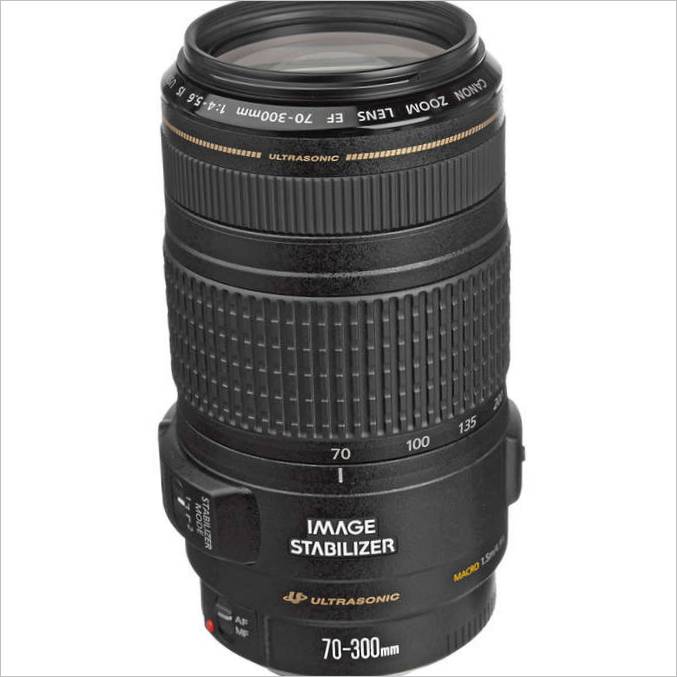
Lightweight and long-range telezoom will always be one of the photographer’s favorite tools. The 70-300mm f/4-5.6 optic offers a very acceptable compromise between affordability and compactness on the one hand and image quality on the other. Nevertheless, the rather low aperture of 300 mm simply calls for optical stabilization, and it is not surprising that this lens class more precisely, the 75-300 was the first swallow, receiving this vital function back in 1995. Exactly ten years later, a new one arrived – with a redesigned optical scheme that, while maintaining the excellent image quality of its predecessor, slightly expanded the range of focal lengths. 3-stop aperture stabilization system and ultrasonic motor for fast and accurate focusing.
Price $380 [IN BEGINNING OF REVIEW]
Nikon 18-55mm f/3.5-5.6G VR AF-S DX
|
Bayonet |
Nikon F |
|
Image Format |
23.5×15.6 mm |
|
Lens construction |
11 elements in 8 groups |
|
Focal length |
18-55mm |
|
Focal length 35mm Eq. |
27-82.5 mm |
|
Maximum aperture |
3,5-5,6 |
|
Minimum aperture |
22-36 |
|
Angle of view |
76° – 29° |
|
Minimum focus distance |
28 cm |
|
Maximum magnification |
0,31h |
|
Number of diaphragm blades |
7 rounded |
|
Hood type |
HB-45 |
|
Light filter diameter |
52 mm |
|
Additional features |
Optical stabilizer 3x |
|
Dimensions |
73 × 79.5 mm |
|
Weight |
265 g |
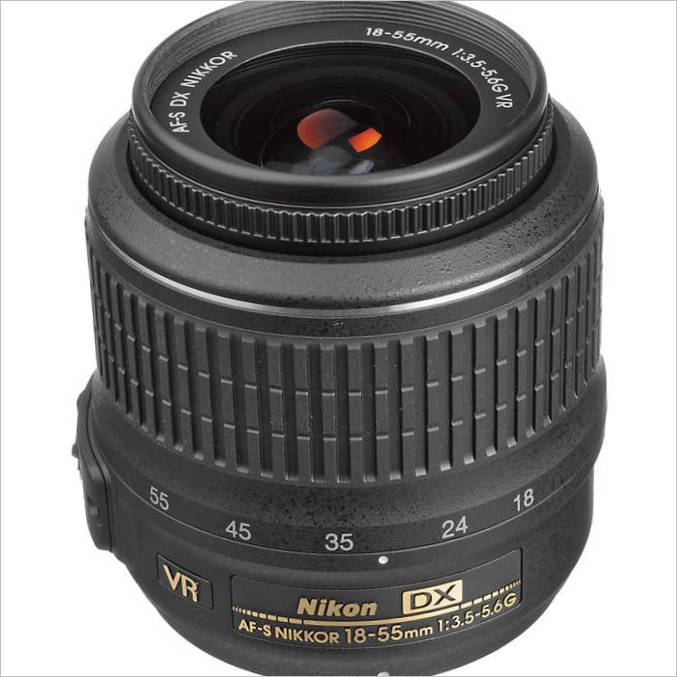
The “Whale” zoom for APS-format models was released in 2007 and has all the good features of lenses in this class: affordability, compactness, lightness, more than sufficient image quality for a beginner and a quite effective stabilization system 3 steps . The optical scheme includes a hybrid aspherical element, which corrects various types of aberrations and provides a sharp, juicy image in general, “Kit” lenses are often leaders in terms of “price – quality” . SWM’s ultrasonic autofocus motor sharpens quickly, accurately and silently. Perhaps the main drawback which is typical of kit zooms is that the front element rotates when focusing, making it difficult to use some filters.
Price $110 [IN BEGINNING OF REVIEW]
Nikon 16-85mm f/3.5-5.6G ED VR AF-S DX Nikkor
|
Bayonet |
Nikon F |
|
Image Format |
23,5×15,6 mm |
|
Lens construction |
17 elements in 11 groups |
|
Focal length |
16-85mm |
|
Focal length 35mm equivalent. |
24-127.5 mm |
|
Maximum aperture |
3,5-5,6 |
|
Minimum aperture |
22-36 |
|
Angle of view |
83° – 18° |
|
Minimum focus distance |
38 cm |
|
Maximum magnification |
0,22h |
|
Quantity aperture blades |
7 rounded |
|
Type of lens hood |
HB-39 |
|
Light filter diameter |
67 mm |
|
Additional options |
optical stabilizer 3.5x |
|
Dimensions |
72 ×85 mm |
|
Weight |
485 g |
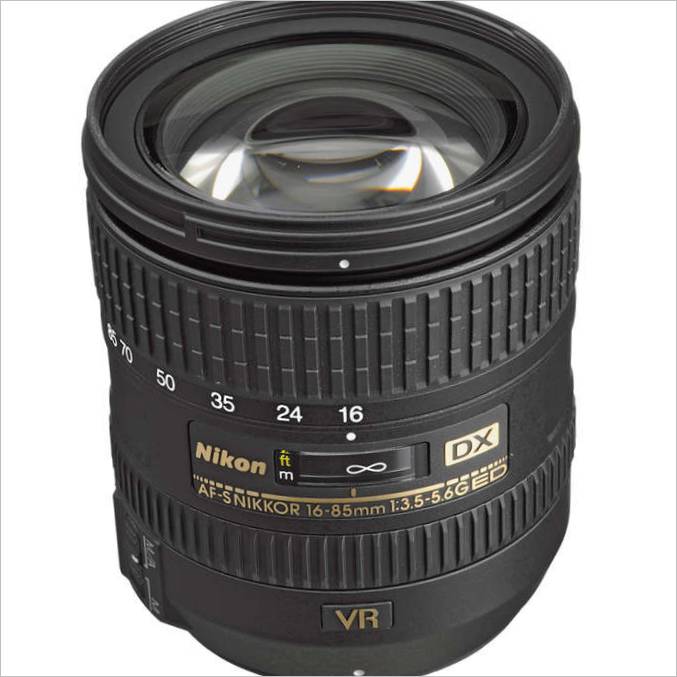
Probably one of Nikon’s most successful and versatile mid-priced zooms. Was released in early 2008. Differ from many of its classmates by the shorter minimum focal length – Eq. 24 mm, t. e. A serious wide angle lens, indispensable for landscapes and cityscapes. Extremely compact. Generates images of very good quality even at open aperture, with outstanding sharpness and moderate aberrations with many of them, such as chromatics and distortion, effectively corrected by RAW file conversion . Has an advanced second-generation optical stabilization system with 4-stop shutter speed efficiency. The optical design uses three aspherical elements and two ultra-low dispersion lenses.
Price $580 [BEGINNING OF REVIEW]
Nikon AF-S DX Nikkor 18-105mm f/3.5-5.6G ED VR
|
Mount |
Nikon F |
|
Image format |
23,5×15,6 mm |
|
Lens construction |
15 elements in 11 groups |
|
Focal length |
18-105mm |
|
Focal length 35mm Eq. |
27-157.5 mm |
|
Maximum aperture |
3,5-5,6 |
|
Minimum aperture |
22-38 |
|
Angle of view |
76° – 15° |
|
Minimal focus distance |
45 cm |
|
Maximum magnification |
0,2h |
|
Number aperture blades |
7 rounded |
|
Hood type |
HB-32 |
|
Light filter diameter |
67 mm |
|
Optional features |
Optical stabilizer 3.5x |
|
Dimensions |
76 ×89 mm |
|
Weight |
420 g |
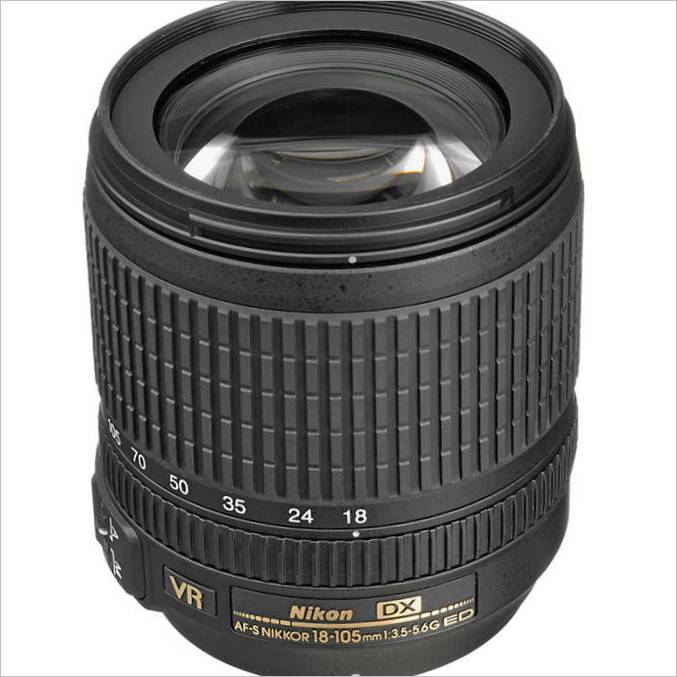
Developed as a “kit” zoom lens of a higher compared to the entry-level class, t. e. By definition affordable, compact and versatile. The front element does not rotate when focusing, making it easier to use filters. Image quality is excellent in the wide-angle and medium focal lengths and only gives up slightly in the tele focal length range however, at this price, the price-quality ratio is still highly attractive . Second-generation optical stabilizer VR II has up to three and a half shutter speeds and a silent ultrasonic autofocus drive for instant sharpness. The optical scheme uses aspherical lenses and ultra-low dispersion elements.
Priced at $280 [IN THE BEGINNING OF THE REVIEW]
Nikon AF-S DX NIKKOR 18-140mm f/3.5-5.6G ED VR
|
Bayonet |
Nikon F |
|
Image format |
23,5×15,6 mm |
|
Lens construction |
17 elements in 12 groups |
|
Focal length |
18-140 mm |
|
Focal length 35 mm equiv. |
27-210mm |
|
Maximum aperture |
3,5-5,6 |
|
Minimum aperture |
22-38 |
|
Angle of view |
76° – 11°30′ |
|
Minimum focus distance |
45 cm |
|
Maximum magnification |
0,23h |
|
Number of aperture blades |
7 rounded |
|
Type of lens hood |
HB-32 |
|
Light Filter Diameter |
67mm |
|
Optional features |
optical stabilizer 4x |
|
Dimensions |
78 ×97 mm |
|
Weight |
490 g |
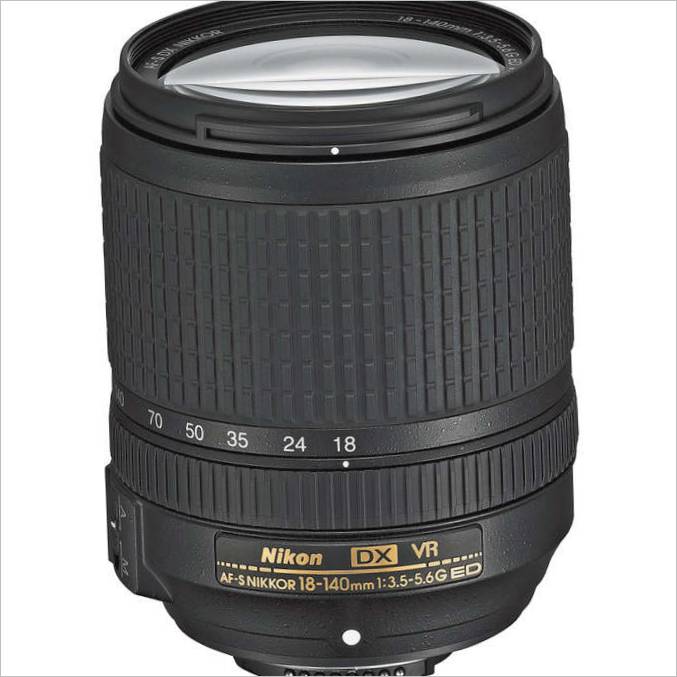
The newest near 8x superzoom to hit the market this summer. Incorporates many of Nikon’s state-of-the-art technological advances, including an efficient 4-stop and silent optical stabilization system that works even when shooting video, and a silent ultrasonic autofocus drive. The lens is compact, has excellent image quality, autofocus precision and reliability, and is built well – hopefully it will survive the odds and tribulations of travel without a hitch. State-of-the-art optical design incorporates aspherical and low-dispersion elements to minimize distortion and provide sharp, contrast-rich images.
Price $380 [IN BEGINNING OF REVIEW]
Nikon AF-S DX Nikkor 18-200mm f/3.5-5.6G ED VRII
|
Bayonet |
Nikon F |
|
Image format |
23,5×15,6 mm |
|
Lens construction |
16 elements in 12 groups |
|
Focal length |
18-200mm |
|
Focal length 35 mm equivalent. |
27-300 mm |
|
Maximum aperture |
3,5-5,6 |
|
Minimum aperture |
22-36 |
|
Angle of view |
76° – 8° |
|
Minimum focus distance |
50 cm |
|
Maximum magnification |
0,22h |
|
Number of aperture blades |
7 rounded |
|
The type of lens hood |
HB-35 |
|
Light filter diameter |
72 mm |
|
Optional features |
optical stabilizer 4x |
|
Dimensions |
77 × 96.5 mm |
|
Weight |
565 g |
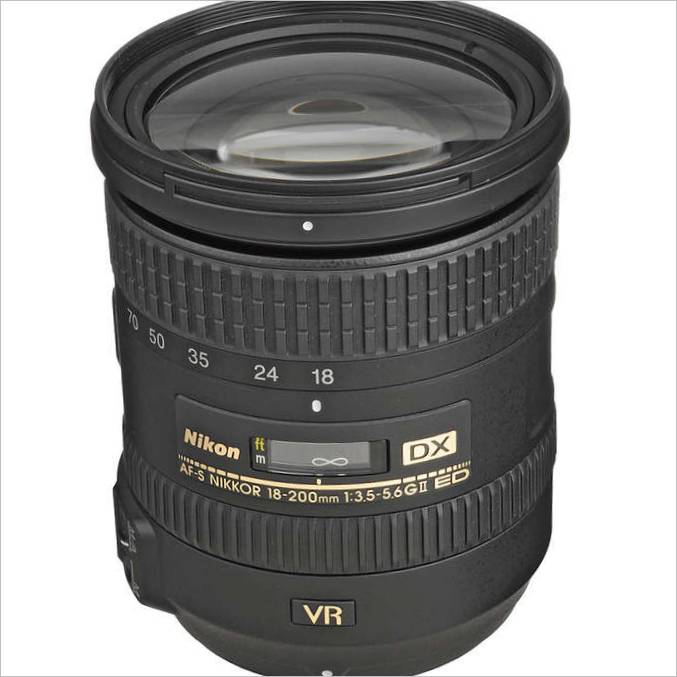
A super-zoom lens with a whopping 11x magnification – Unless you’re a true wide angle shooter, it’s an all round solution for travel and eliminates the need to lug an interchangeable lens and change optics in unpredictable situations. But you have to pay for convenience, and not just in money, but also in image quality. Despite the use of special elements in the optical scheme, the tele-range in the picture is noticeably inferior to the wide angle and the middle part, is also quite pronounced aberration. Quick autofocus and effective stabilization system are, however, undeniable pluses of the lens. Summary: if a constant availability is more important – fine, if you want flawless picture – better to take two separate zooms.
Price $700 [IN BEGINNING OF REVIEW]
Nikon AF-S Nikkor DX 18-300mm f/3.5-5.6G ED VR
|
Bayonet |
Nikon F |
|
Image Format |
23.5×15.6 mm |
|
Lens construction |
19 elements in 14 groups |
|
Focal length |
18-300mm |
|
Focal length 35mm equivalent. |
27-450 mm |
|
Maximum aperture |
3,5-5,6 |
|
Minimum aperture |
22-32 |
|
angle of view |
76° – 5° |
|
Minimum focus distance |
45 cm |
|
Maximum magnification |
0,15h |
|
Quantity aperture blades |
9 rounded |
|
Type of lens hood |
HB-58 |
|
Light filter diameter |
77 mm |
|
Extras capabilities |
optical stabilizer 4x |
|
Dimensions |
83 ×120 mm |
|
Weight |
830 g |
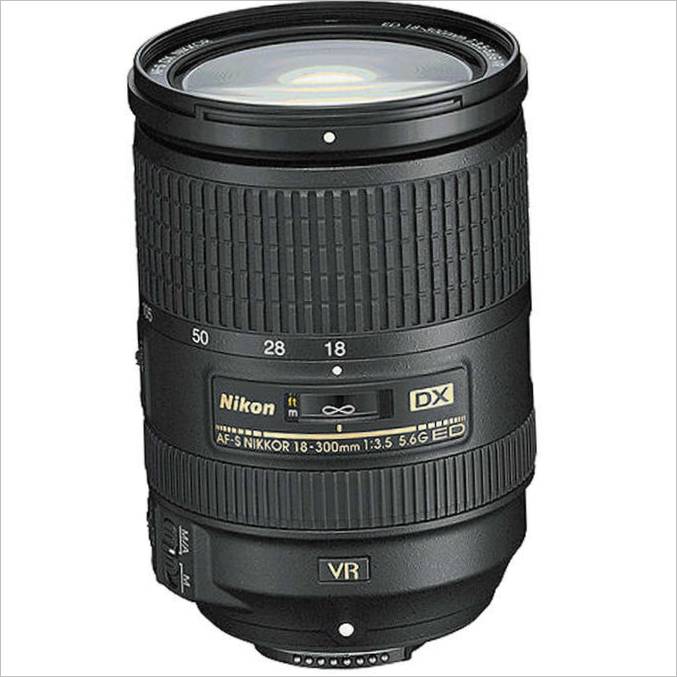
Superzoom-record holder in terms of magnification, not only in Nikon’s lineup, but among all the interchangeable lenses on the planet – 16.7x eq. 27-450 mm . It also holds another record: it is the most bulky, heavy and expensive zoom for cameras with a “cropped” sensor, although it would look very modest in the full frame sector. Released in the summer of 2012, it fully incorporates Nikon’s latest technologies: second-generation stabilization, superior coatings, fast silent autofocus. The sophisticated 19-lens optical scheme features three ultra-low dispersion elements and three aspherical lenses. However, it has enough problems typical for superzooms: mediocre imaging in the TV range, lack of sharpness at the frame edges, and the efficiency of the stabilizer in the zoom of this magnitude is obviously reduced. Your choice – convenience or picture perfection.
Price $860 [BEGINNING OF REVIEW]
Nikon AF-S DX VR Zoom-Nikkor 55-200mm f/4-5.6G IF-ED
|
Mount |
Nikon F |
|
Image format |
23.5×15.6 mm |
|
Lens construction |
15 elements in 11 groups |
|
Focal length |
55-200mm |
|
Focal length 35mm equivalent. |
82.5-300mm |
|
Maximum aperture |
4-5,6 |
|
Minimum aperture |
22-32 |
|
Angle of View |
29° – 8° |
|
Minimum focus distance |
110 cm |
|
Maximum magnification |
0,29h |
|
Number of aperture blades |
7 rounded |
|
Type of lens hood |
HB-37 |
|
Light filter diameter |
52 mm |
|
More features |
optical stabilizer 3x |
|
Dimensions |
73 × 99.5 mm |
|
Weight |
335 g |
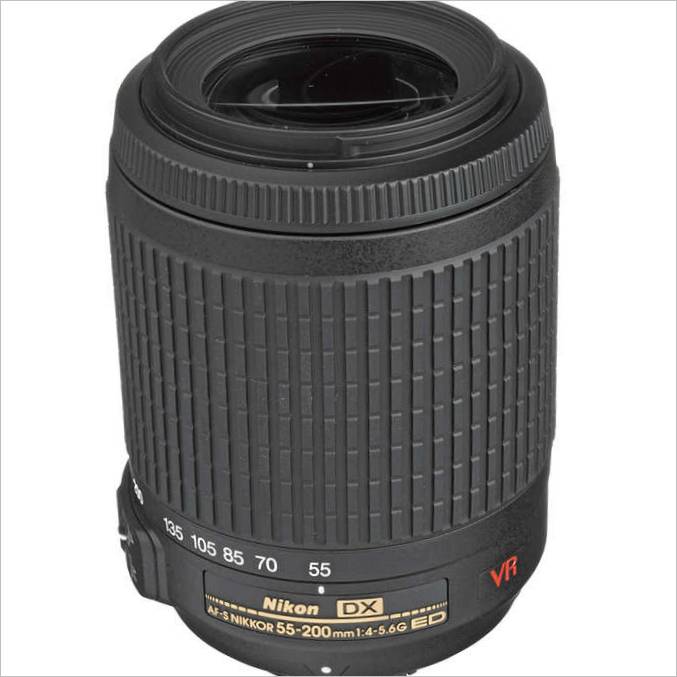
The budget telezoom is one of the most popular offerings for the hobbyist, replacing an earlier model without the stabilizer. The build quality is improved over its predecessor and the body is noticeably sturdier. Focal length range covers the most needed for portraits, events and landscapes – eq. 82-300 mm. However, the budget lens affects the stabilizer performance: practice shows that the claimed 3 steps are in fact closer to two. The speed and precision of the advanced autofocus system and the quality of the lenses, critical for rich contrast in backlight and sidelight, deserve excellent marks. Overall image quality is very good, especially at shorter focal lengths.
Price $170 [IN BEGINNING OF REVIEW]
Nikon AF-S Nikkor 55-300mm f/4.5-5.6G ED VR
|
Bayonet |
Nikon F |
|
Image format |
23,5×15,6 mm |
|
Lens design |
17 elements in 11 groups |
|
Focal length |
55-300mm |
|
Focal length 35mm eq. |
82,5-450 mm |
|
Maximum aperture |
4,5-5,6 |
|
Minimum aperture |
22-29 |
|
Angle of View |
29° – 5° |
|
Minimal focus distance |
140 cm |
|
Maximum magnification |
0,28h |
|
Number of aperture blades |
9 rounded |
|
Hood type |
HB-57 |
|
Light Filter Diameter |
58mm |
|
Additional features |
optical stabilizer 3x |
|
Dimensions |
76.5 ×123 mm |
|
Weight |
530 g |
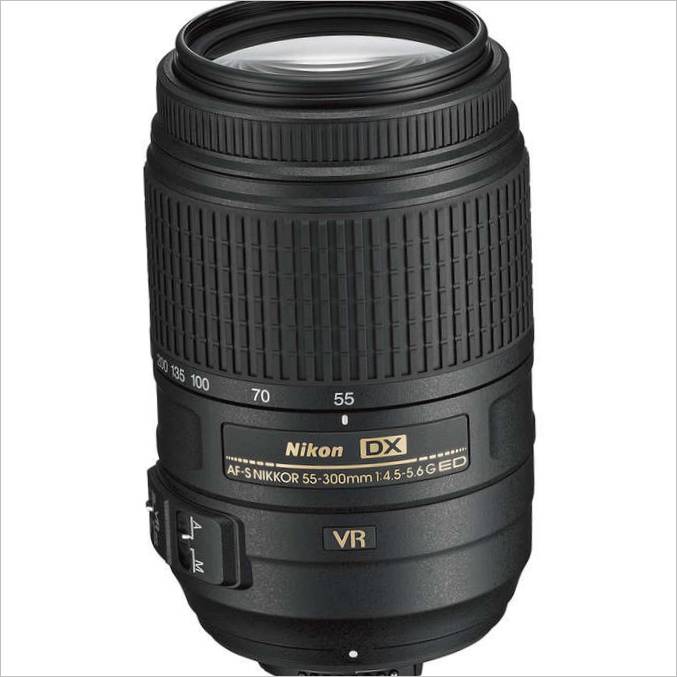
Another budget telezoom designed to pair with the standard kit lens but with an increased magnification of up to Eq. 450 mm. Although the optical scheme uses several lenses of special grades of optical glass and the stabilization system belongs to the advanced second generation with a claimed efficiency of 4 steps, the price of the lens remains very forgiving. The stabilizer automatically detects when the camera is mounted on a tripod and selects the appropriate mode. Rubber ring around the lens mount provides dust protection. However, the autofocus speed leaves a lot to be desired, and the front element rotates – a consequence of the fact that focusing is done by moving the entire optical unit, rather than a group of lenses inside the body. Superb image quality, including in the telephoto range, a rarity for this class of lens.
Price $280 [IN BEGINNING OF REVIEW]
Nikon AF-S Nikkor 24-85mm f/3.5-4.5G ED VR
|
Bayonet |
Nikon F |
|
Image format |
24×36 mm |
|
Lens design |
16 elements in 11 groups |
|
Focal length |
24-85mm |
|
Focal length |
(for APS format, Eq. 36-127,5 mm |
|
Maximum aperture |
3,5-4,5 |
|
Minimum aperture |
22-29 |
|
Angle of view |
84° – 28° |
|
Minimal focus distance |
38 cm |
|
Maximum magnification |
0,22h |
|
Number of blades apertures |
7 rounded |
|
Hood type |
HB-63 |
|
Light filter diameter |
72mm |
|
Optional features |
optical stabilizer 4x |
|
Dimensions |
78 ×82 mm |
|
Weight |
465 g |
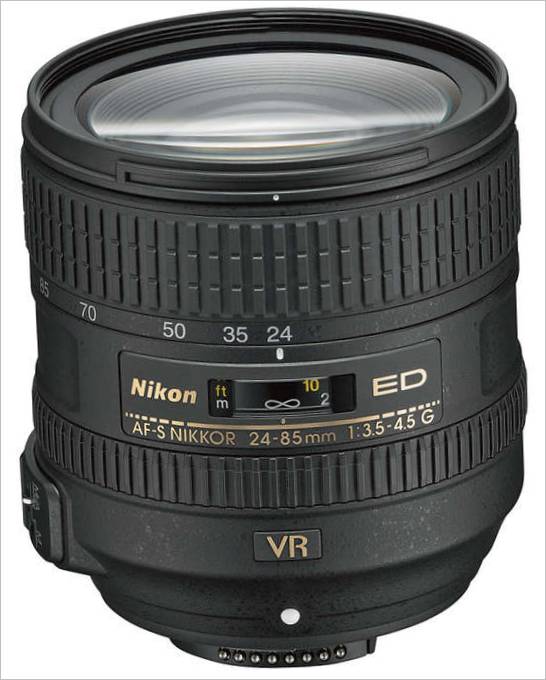
Standard zoom for full-frame cameras that offers a good middle ground both in terms of the most popular focal lengths and in terms of price. Designed to be the main workhorse for those photographers who can’t afford super-professional optics like the 24-70/2.8. High quality build and build quality: the lens is designed to withstand the rigors of everyday use. The speed and precision of the autofocus and the effectiveness of the stabilization system deserve the highest marks. As for image quality, you can clearly see the difference from the 24-70/2.8: Although sharpness in the center of the frame is excellent at all apertures and focal lengths, the edges and corners are very noticeably inferior, especially in the wide-angle range. Also aberrations such as distortion, chromatics and vignetting are quite pronounced.
Priced at $520 [IN THE BEGINNING OF THE REVIEW]
Nikon AF-S VR Zoom-Nikkor 70-300mm f/4.5-5.6G IF-ED
|
Bayonet |
Nikon F |
|
Image format |
24×36 mm |
|
Lens design |
17 elements in 12 groups |
|
Focal length |
70-300 mm |
|
Focal length |
(for APS format, Eq. 105-450 mm |
|
Maximum aperture |
4,5-5,6 |
|
Minimum aperture |
32-40 |
|
Angle of view |
34° – 8° |
|
Minimum focus distance |
150 cm |
|
Maximum magnification |
0,25h |
|
Number of aperture blades |
9 rounded |
|
Type of hood |
HB-36 |
|
Light filter diameter |
67 mm |
|
Optional capabilities |
optical stabilizer 4x |
|
Dimensions |
80 × 143,5 mm |
|
Weight |
745 g |
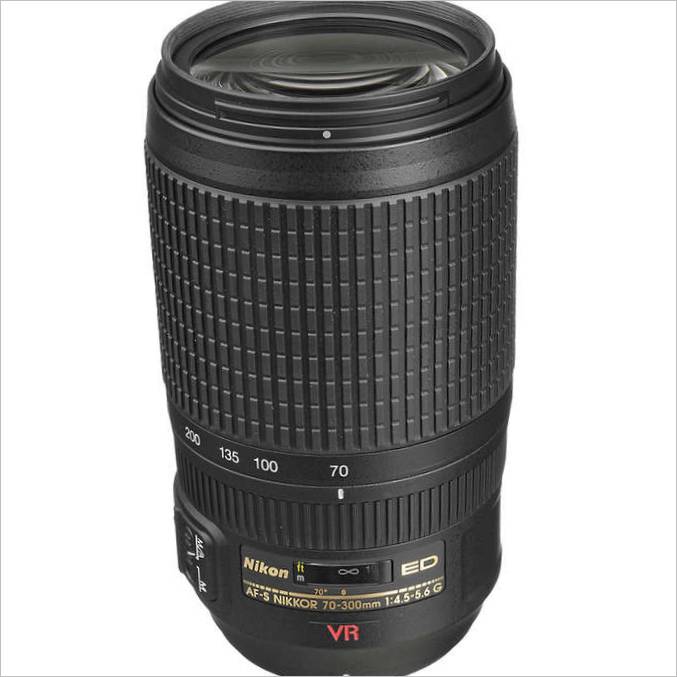
Very practical and relatively affordable full frame telephoto. Internal autofocus, t. e. Moves a small lens group inside the lens and is therefore very fast, precise and almost silent manual focus correction is possible at any time. Front element does not rotate when focusing. Image quality at shorter focal lengths is excellent, but, as you might expect, declines slightly in the 200-300mm range. Chromatic aberration inherent to televisions, but easily corrected in the editor. 9-blade iris for beautiful background blur. The optical stabilization system works very well, practical tests generally confirm the claimed efficiency of about four steps.
Price $510 [IN THE BEGINNING OF THE REVIEW]
Sigma 17-50mm f/2.8 EX DC OS HSM
|
Mount |
Canon EF, Nikon F, Sony A, Pentax K, Sigma SA |
|
Image format |
23.5×15.6 mm |
|
Lens design |
17 elements in 13 groups |
|
Focal length |
17-50mm |
|
Focal length 35mm eq. |
25.5-75 mm |
|
Maximum aperture |
2,8 |
|
Minimum aperture |
22 |
|
Angle of view |
80° – 28° |
|
Minimum focus distance |
28 cm |
|
Maximum magnification |
0,20h |
|
Number of aperture blades |
7 rounded |
|
Type of hood |
LH825-03 583 |
|
Light filter diameter |
77 mm |
|
Optional features |
Optical stabilizer 4x 2 FLD glass elements |
|
Dimensions |
83.5 × 91.8 mm |
|
Weight |
565 g |
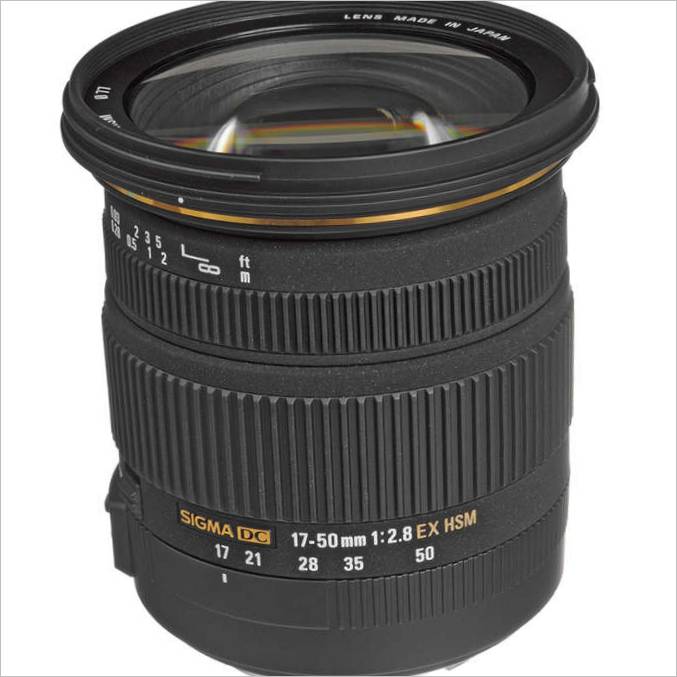
The standard fast zoom, launched in 2010, was one of the first to use lenses made of the newly invented proprietary FLD glass, which the company claims is similar in its properties to the very expensive fluorite glass only used in high-end lenses. The result is impressive: in many respects, this zoom is on par with or even outperforms similar zooms from leading brands, while being about half the price. The sharpness in the center of the frame is exceptional at all apertures and focal lengths, albeit at open apertures it drops sharply at the edges, but already at f/4 the situation improves considerably and the image has excellent evenness over the whole frame. Auto focus is quite fast, almost silent and accurate, although manual override is not possible. All in all, excellent value for money.
Price $490 [IN BEGINNING OF REVIEW]
Sigma 17-70mm f/2.8-4 DC Macro OS HSM
|
Bayonet |
Canon EF, Nikon F, Sony A, Pentax K, Sigma SA |
|
Image format |
23,5×15,6 mm |
|
Lens construction |
16 elements in 14 groups |
|
Focal length |
17-70mm |
|
Focal length 35mm Eq. |
25,5-105 mm |
|
Maximum aperture |
2,8-4 |
|
Minimum aperture |
22 |
|
Angle of View |
80° – 23° |
|
Minimum focus distance |
22 cm |
|
Maximum magnification |
0,34h |
|
Number of aperture diaphragm blades |
7 rounded |
|
Hood type |
LH7805-03 884 |
|
Light filter diameter |
72 mm |
|
Extra features |
Optical stabilizer 4x , USB dock for fine-tuning and reflashing |
|
Dimensions |
79 ×82 mm |
|
Weight |
465 g |
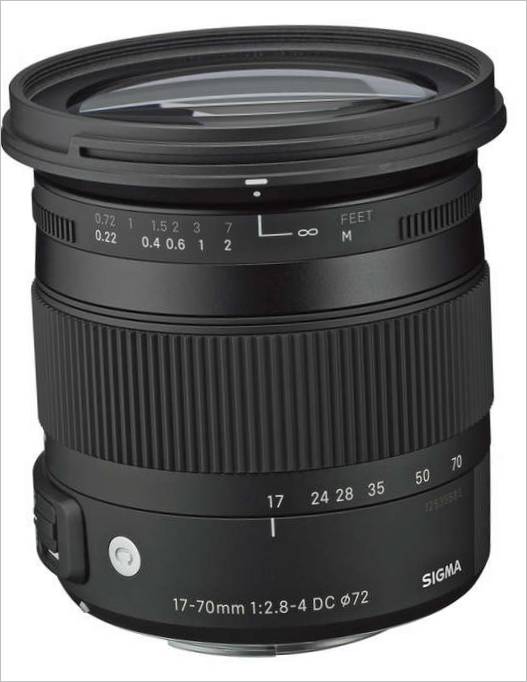
The first lens in our new signature Contemporary series is an enhanced version of our popular mid-range standard zoom lens. Added not only an optical stabilization system, but also a supersonic autofocus drive, in addition, the lens became slightly more aperture at the long end of the zoom F4 versus the previous F4.5 . Stabilizer’s claimed performance 4x is confirmed by practical tests. Build quality is good and the lens is designed to withstand intensive everyday use. The optical performance is typical for this class of lens: excellent center sharpness at wide-angle is slightly reduced at long focal lengths, but the telephoto image is more evenly distributed across the frame. Light and compact body is made of thermally stable material that ensures smooth operation under significant temperature fluctuations.
Price $480 [BEGINNING OF REVIEW]
Sigma 18-200mm f/3.5-6.3 II DC OS HSM
|
Bayonet |
Canon EF, Nikon F, Sony A, Pentax K, Sigma SA |
|
Image format |
23.5×15.6mm |
|
Lens construction |
18 elements in 14 groups |
|
Focal length |
18-200 mm |
|
Focal length 35mm eq. |
27-300 mm |
|
Maximum aperture |
3,5-6,3 |
|
Minimum aperture |
22 |
|
Angle of view |
76° – 8° |
|
Minimum focus distance |
45 cm |
|
Maximum magnification |
0,26h |
|
Number of aperture blades |
7 rounded |
|
Type of hood |
LH680-01 |
|
Light filter diameter |
62mm |
|
Additional features |
Optical stabilizer 4x |
|
Dimensions |
75 ×88 mm |
|
Weight |
490 g |
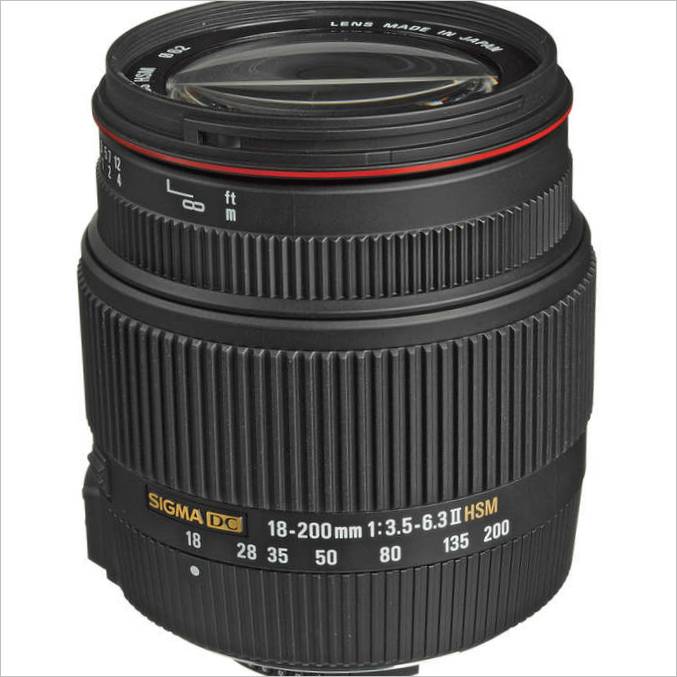
The new incarnation of the budget superzoom for those who like trouble-free shooting and aren’t particularly picky about image quality. The lens is equipped with the latest Sigma technological achievements ultrasonic autofocus drive with inner focusing, quite effective optical stabilization, fluorite-like FLD glass lens and is fully endowed with both classic superzoom advantages and disadvantages. Relatively compact and lightweight, it covers the most popular range of focal lengths, but does not provide decent sharpness at all of them – the middle part of the range is the weakest. On the other hand, the spherical aberrations are well corrected, so the zoom is good for those who shoot for the Internet or for small format printing – there is no need for extreme sharpness, and the geometry of the frame will be correct from the beginning.
Price $350 [BEGINNING OF REVIEW]
Sigma 18-250mm F3.5-6.3 DC Macro OS HSM
|
Mount |
Canon EF, Nikon F, Sony A, Pentax K, Sigma SA |
|
Image format |
23.5×15.6mm |
|
Lens construction |
16 elements in 13 groups |
|
Focal length |
18-250mm |
|
Focal length 35mm equivalent. |
27-375 mm |
|
Maximum aperture |
3,5-6,3 |
|
Minimum aperture |
22 |
|
Viewing angle |
76° – 6° |
|
Minimal focus distance |
35 cm |
|
Maximum magnification |
0,34h |
|
Number of aperture blades |
7 rounded |
|
Hood type |
LH680-04 883 |
|
Light Filter Diameter |
62 mm |
|
Extra features |
optical stabilizer 4x |
|
Dimensions |
74 ×89 mm |
|
Weight |
470 g |
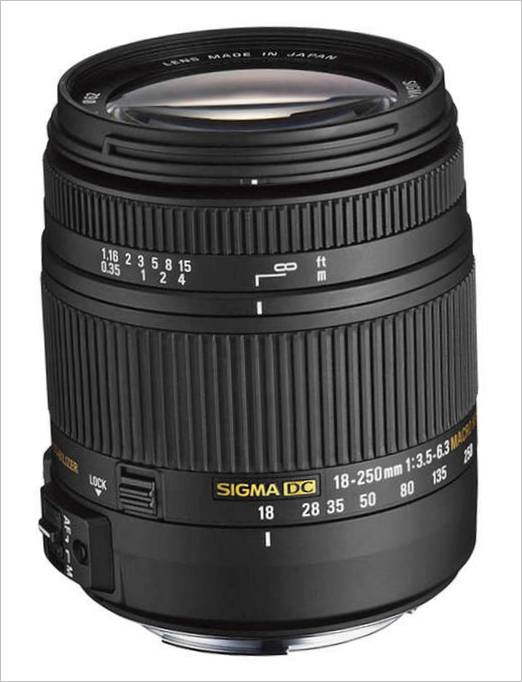
Yet another of Sigma’s recent massive lineup upgrades. Judging by the name, you might think that this super zoom is just a new version of its predecessor with the same magnification in fact, it has changed the optical design and therefore the image. The lens is now much lighter and more compact, plus macro capabilities have been greatly improved the minimum focusing distance is only 35 cm . The body is made of thermally stable material and is quite reliable. Image quality has improved, especially in the TV range, but the medium focal lengths are slightly inferior. Stabilization system efficiency of about 4 steps, state-of-the-art internal focusing ensures fast and accurate focus – in this respect the lens outperforms many competitors.
Price $450 [BEGINNING OF REVIEW]
Sigma 24-105mm F/4 DG OS HSM
|
Bayonet |
Canon EF, Nikon F, Sony A, Sigma SA |
|
Image format |
24×36 mm |
|
Lens design |
19 elements in 14 groups |
|
Focal length |
24-105 mm |
|
Focal length |
(for APS format, Eq. 36-152.5 mm |
|
Maximum aperture |
4 |
|
Minimum aperture |
22 |
|
Angle of view |
84° – 23° |
|
Minimum focus distance |
45 cm |
|
Maximum magnification |
0,22h |
|
Number of aperture diaphragm blades |
9 rounded |
|
Type of hood |
N/A |
|
Light Filter Diameter |
82 mm |
|
Additional capabilities |
Optical stabilizer 4x , USB dock for fine-tuning and flashing |
|
Dimensions |
88.6 × 109.4 mm |
|
Weight |
885 g |
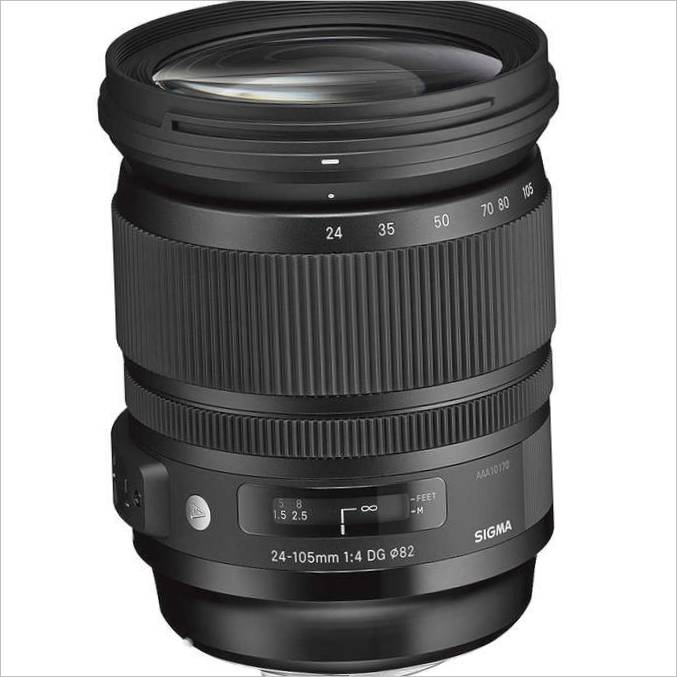
The resounding success of several lenses of the new Art series seems to have inspired Sigma to create a high-end zoom lens designed for use with today’s high resolution full frame sensors. Its optical scheme uses lenses made of special types of glass, including FLD, similar to fluorite, to effectively suppress aberrations. The zoom body is made of a thermally stable material for lightweight, reliable construction, and smooth operation over a wide temperature range. Many of the lens parameters can be adjusted for yourself using a USB dock and a special program moreover, the company offers a unique service – the change of bayonet mount at an affordable price, t. e. photographers will not have to buy an entire fleet of optics when switching to another system.
Price: new [IN BEGINNING OF REVIEW]
Tamron SP AF 17-50mm F/2.8 XR Di II VC LD
|
Bayonet |
Canon EF, Nikon F, Sony A |
|
Image format |
23,5×15,6 mm |
|
Lens design |
19 elements in 14 groups |
|
Focal length |
17-50 mm |
|
Focal length 35mm equivalent. |
25,5-75 mm |
|
Maximum aperture |
2,8 |
|
Minimum aperture |
32 |
|
Angle of view |
78° – 31° |
|
Minimum Focus distance |
29 cm |
|
Maximum magnification |
0,21h |
|
Number of aperture blades |
7 rounded |
|
Type of hood |
AB003 |
|
Light filter diameter |
72 mm |
|
Optional features |
Optical Stabilizer 4x |
|
Dimensions |
79.6 × 94.5 mm |
|
Weight |
570 g |
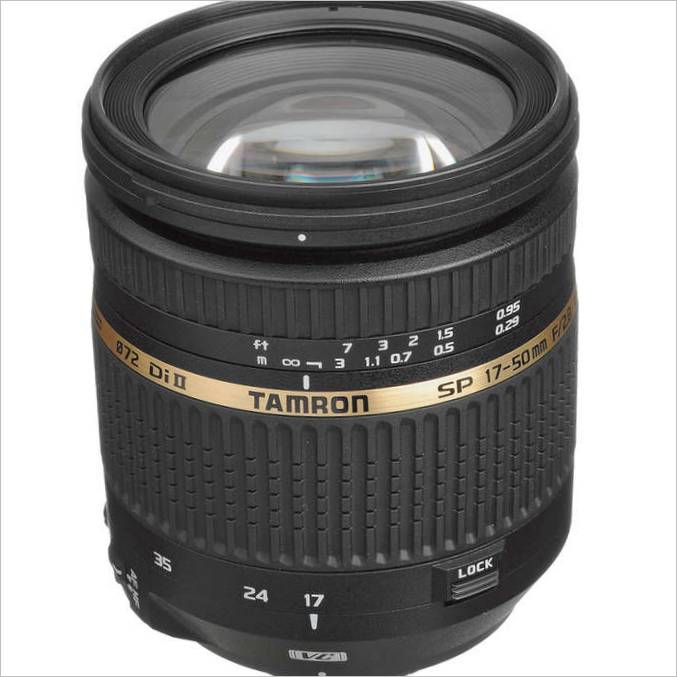
SP in the name of the lens means belonging to the higher class of Tamron optics. The optical scheme has several elements of special grades of glass and aspherical lenses. Proprietary VC stabilization system compensates for lens vibration on three axes and has up to 4X efficiency. The autofocus system, however, looks a little outdated: its speed is slightly inferior to the competition, but the autofocus is quite loud. Resolution in the center of the frame is very high at all apertures and focal lengths except for the 50mm – f/2.8 pairing , edges are noticeably inferior at f/2.8, but improve dramatically at just one aperture. The lens has its own distinctive pattern and the image is lush, vivid and rich in contrast. Virtually no chromatic aberration.
Price $520 [IN BEGINNING OF REVIEW]
Tamron AF 18-270mm f/3.5-6.3 Di II VC PZD AF
|
Bayonet |
Canon EF, Nikon F, Sony A |
|
image format |
23.5×15.6 mm |
|
Lens construction |
16 elements in 13 groups |
|
Focal length |
18-270 mm |
|
Focal length 35mm equivalent. |
27-405 mm |
|
Maximum aperture |
3,5-6,3 |
|
Minimum aperture |
22-40 |
|
Angle of View |
75° – 6° |
|
Minimum focusing distance |
49 cm |
|
Maximum magnification |
0,26h |
|
Number of aperture blades |
7 rounded |
|
Type of lens hood |
DA18 |
|
Light filter diameter |
62 mm |
|
Additional options |
optical stabilizer 4x |
|
Dimensions |
74 × 96.4 mm |
|
Weight |
450 g |
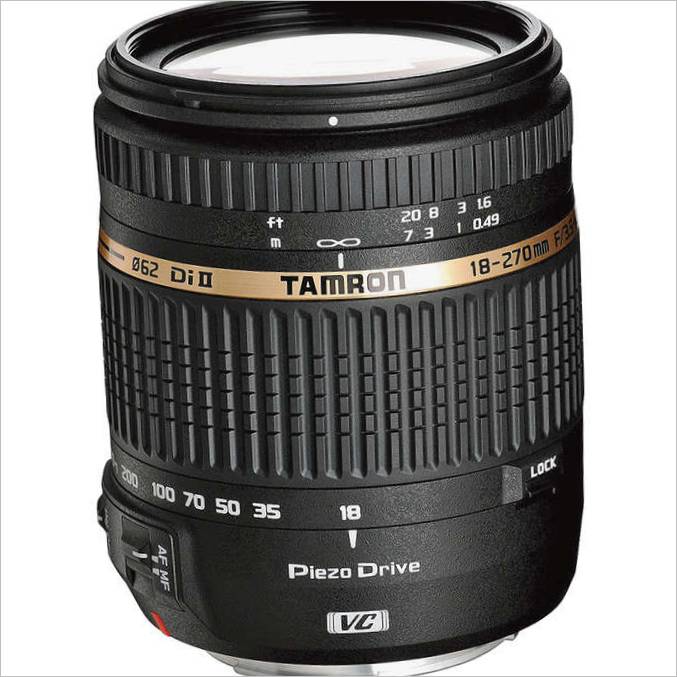
The versatility, well-balanced performance and low price of this super zoom lens have brought it not only the well-deserved popularity, but also the honorary title of “European zoom 2011-12. ” by the prestigious EISA. For a long time, the 18-270 mm Tamron zooms were record-breaking magnifications the current version has been refined in several important areas, most notably the autofocus, which has received an ultrasonic piezo drive. The lens is compact and lightweight for its class, the proprietary optical stabilization system works with confidence, justifying the claimed effectiveness of 4 steps. Image quality, however, remains typical of superzooms: sharp center, very soft edges of the frame, pronounced distortion especially in the TV range, where all image features noticeably degrade .
Price $230 [IN BEGINNING OF REVIEW]
Tamron 28-300mm f/3.5-6.3 XR Di VC LD Aspherical IF Macro
|
Bayonet |
Canon EF, Nikon F, Sony A |
|
Image format |
24×36 mm |
|
Lens design |
18 elements in 13 groups |
|
Focal length |
28-300mm |
|
Focal length |
(for APS format, Eq. 42-450mm |
|
Maximum aperture |
3,5-6,3 |
|
Minimum aperture |
22 |
|
Angle of view |
75° – 8° |
|
Minimum focus distance |
49 cm |
|
Maximum magnification |
0,33h |
|
Number of aperture diaphragm blades |
9 rounded |
|
Type of lens hood |
DA20 |
|
Light filter diameter |
67 mm |
|
Supplementary capabilities |
optical stabilizer ?x |
|
Dimensions |
78 ×99 mm |
|
Weight |
555 g |
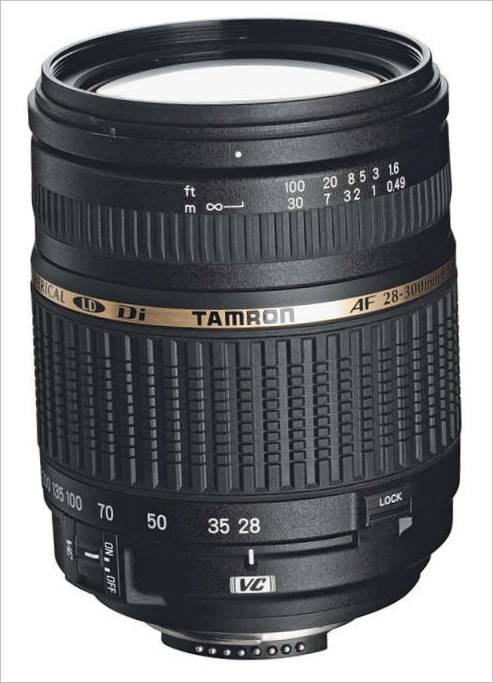
This full-frame superzoom was voted EISA Best Amateur Lens 2008-09 for its versatility and usability. The 28-300mm zooms Tamron has been producing for many years and have been steadily improving and enhancing their popularity. The modern version is the first in the brand line received a three-axis optical stabilization system with an efficiency of 4 steps according to the manufacturer, is particularly effective in the TV range , in addition, its optical scheme has been optimized for digital photography. The lens is relatively compact and lightweight for its class. True, the autofocus is quite outdated by today’s standards – not ultrasonic and without the possibility of manual correction. The lens allows for macro photography, with a minimum focus distance of just 49 cm.
Price $740 [IN BEGINNING OF REVIEW]
Tamron SP 24-70mm f/2.8 Di VC USD
|
Bayonet |
Canon EF, Nikon F, Sony A |
|
Image format |
24×36 mm |
|
Lens design |
17 elements in 12 groups |
|
Focal length |
24-70mm |
|
Focal length |
(for APS format, eq. 36-105 mm |
|
Maximum aperture |
2,8 |
|
Minimum aperture |
22 |
|
Angle of view |
84° – 34° |
|
Minimal focus distance |
38 cm |
|
Maximum magnification |
0,2h |
|
Number of aperture blades |
9 rounded |
|
Hood type |
HA007 |
|
Light filter diameter |
82 mm |
|
Optional options |
optical stabilizer 4x |
|
Dimensions |
88.2 × 116.9 mm |
|
Weight |
825 g |
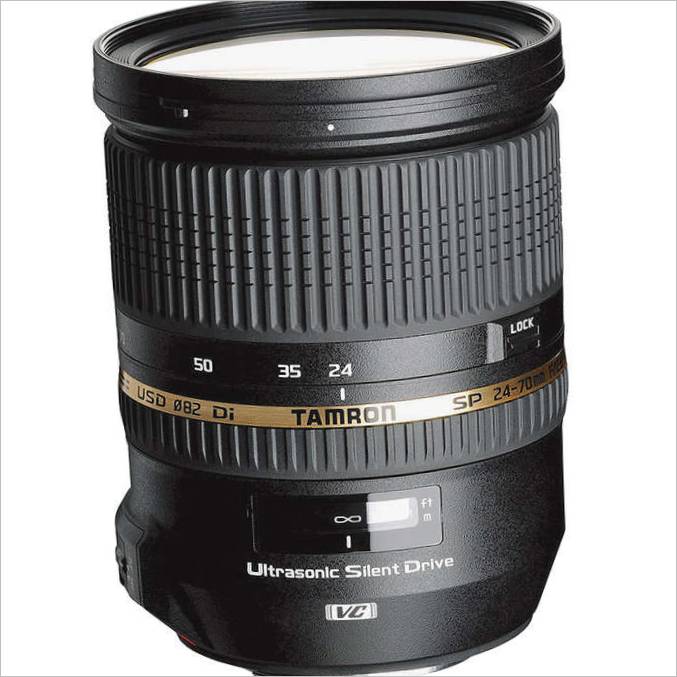
Unique and one of a kind so far, combining all the features of the professional standard zoom 24-70/2.8 and optical stabilization system. Next-generation optics offering superb image quality rivaling that of the zooms from leading manufacturers. Digital-optimized optical design features multiple lenses in special glass grades proprietary multi-coated lenses for superior micro-contrast and effective against glare and flare. The best image quality is achieved at the wide-angle end of the range. An advanced stabilization system provides 4 additional shutter speeds and an ultrasonic AF motor for fast, accurate and silent autofocus. The lens body is protected against moisture and dust.
Price $1010 [BEGINNING OF REVIEW]
Tamron SP 70-300mm f/4-5.6 Di VC USD
|
Bayonet |
Canon EF, Nikon F |
|
Image format |
24×36 mm |
|
Lens design |
17 elements in 12 groups |
|
Focal length |
70-300 mm |
|
Focal length |
(for APS format, Eq. 105-450 mm |
|
Maximum aperture |
4-5,6 |
|
Minimum aperture |
32-45 |
|
Angle of view |
34° – 8° |
|
Minimum focus distance |
150 cm |
|
Maximum magnification |
0,25h |
|
Number of aperture blades |
9 rounded |
|
Hood types |
HA005 |
|
Light filter diameter |
62 mm |
|
More features |
Optical stabilizer 4x |
|
Dimensions |
81.5 × 142.7 mm |
|
Weight |
765 g |
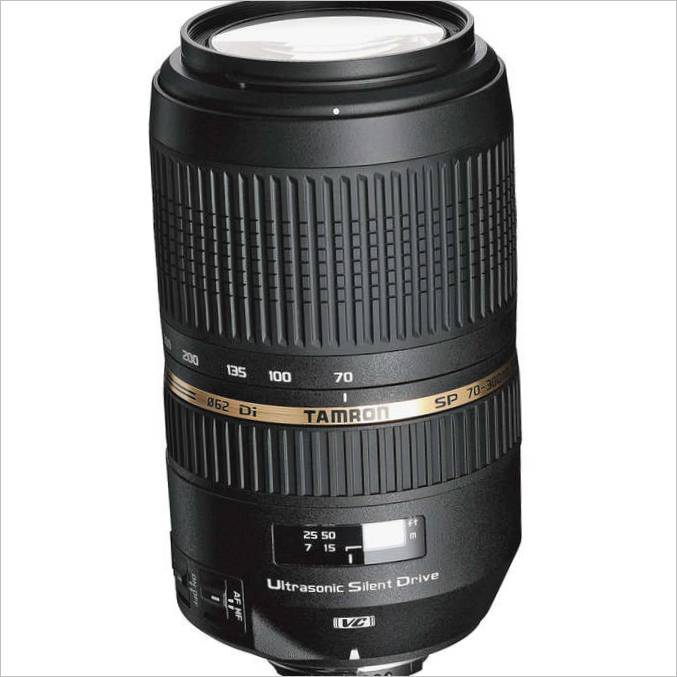
A medium telephoto zoom lens popular with travel photographers due to its compact size and lightness, its effective optical stabilization system and excellent image quality. Part of the professional SP series and the first Tamron lens to feature the latest silent ultrasonic autofocus system USD . The autofocus speed and precision is uncompromising, and manual override is possible at all times. Stabilization system has 4-stop shutter efficiency. Several low and extra-low dispersion glass elements that deliver rich, high contrast images with low chromatic aberration and outstanding color reproduction. Image sharpness is very good at short and medium focal lengths, dropping slightly in the telefocal range.
Price $460 [IN BEGINNING OF REVIEW]

What are some budget options for lenses with optical stabilization and how effective is this feature in achieving stability en masse?
Which budget lenses with optical stabilization would you recommend for ensuring stability in mass photography?
I would recommend the Canon EF-S 55-250mm f/4-5.6 IS STM lens or the Nikon AF-P DX NIKKOR 70-300mm f/4.5-6.3G ED VR lens. These lenses offer optical stabilization and are budget-friendly options that can help ensure stability in mass photography situations. Both lenses have a versatile zoom range, allowing you to capture subjects at various distances, and their optical stabilization feature helps to minimize camera shake, resulting in sharper images. They are lightweight and compact, making them convenient for extended shooting periods. Overall, these lenses provide good value for money while delivering stability and quality images in mass photography settings.